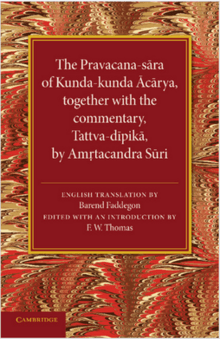Pravachanasara
Pravachanasara, is a text composed by Jain monk, Kundakunda, in the second century CE or later.[2][3] The title means "Essence of the Scripture", and it largely deals with the correct ascetic and spiritual behavior based on his dualism premise.[3] Kundakunda provides a rationale for nudity among Digambara monks in this text, stating that the duality of self and of others means "neither I belong to others, nor others belong to me, therefore nothing is mine and the ideal way for a monk to live is the way he was born".[4] The text is written in Prakrit language, and it consists of three chapters and 275 verses.
| Pravachanasara | |
|---|---|
 Text along with commentary of Pravachanasara in English | |
| Information | |
| Religion | Jainism |
| Author | Kundakunda |
| Language | Prakrit |
| Period | 2nd Century CE or later / 1934 Translated in English |
| Chapters | 3 |
| Verses | 275[1] |
| Part of a series on |
| Jainism |
|---|
 |
|
Jain prayers |
|
Ethics |
|
Major sects |
|
Texts |
|
Festivals
|
|
|
Content
First chapter consists of 92 verses and it describes attributes of Supreme Beings and outlines the first steps in the process of transforming oneself into a Supreme Being. Second chapter consists of 108 verses and it describes laws of interaction between space, time particles, elementary matter particles, compound matter particles, motion and souls in the Cosmos. Third chapter consists of 75 verses and it is aimed at delineating the bases of correct mendicant praxis.
Commentaries
Acharya Amritchandra has written a commentary on Kundkund Acharya's Pravachansara titled Tattvadipika (i.e. the Lamp of Truth). Acharya Jayasena has also written a commentary on Pravachanasara titled Tatparyavritti (i.e. the Purport).[5] Another commentary was written by Hemraj Pande in 1652 based on the commentary on Samayasara by Rajmall.[6]
See also
References
Citations
- Jaini 1991, p. 33.
- Cort 1998, p. 69.
- Dundas 2002, pp. 107-109.
- Cort 1998, pp. 10-11.
- Jaini 1991, p. 139.
- Orsini & Schofield 1981, pp. 87-88.
Sources
- Upadhyay, A. N (1935), Pravachanasara, Param-Śruta Prabhavaka Mandala
- Cort, John E. (10 July 1998), Open Boundaries: Jain Communities and Cultures in Indian History, SUNY Press, ISBN 0-7914-3785-X
- Dundas, Paul (2002) [1992], The Jains (Second ed.), London and New York: Routledge, ISBN 978-0-415-26605-5
- Jaini, Padmanabh S. (1991), Gender and Salvation: Jaina Debates on the Spiritual Liberation of Women, University of California Press, ISBN 0-520-06820-3
- Orsini, Francesca; Schofield, Katherine Butler, eds. (1981), Tellings and Texts: Music, Literature and Performance in North India, Open Book Publishers, ISBN 978-1-78374-105-2
